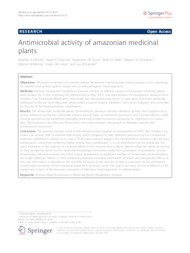Antimicrobial activity of amazonian medicinal plants.
Antimicrobial activity of amazonian medicinal plants.
Author(s): OLIVEIRA, A. A.; SEGOVIA, J. F. O.; SOUSA, V. Y. K.; MATA, E. C. G.; GONÇALVES, M. C. A.; BEZERRA, R. M.; M. JUNIOR, P. O.; KANZAKI, L. I. B.
Summary: The aqueous extracts of currently utilized Amazonian medicinal plants were assayed in vitro searching for antimicrobial activity against human and animal pathogenic microorganisms. Medium resuspended lyophilized aqueous extracts of different organs of Amazonian medicinal plants were assayed by in vitro screening for antimicrobial activity. ATCC and standardized microorganisms obtained from Oswaldo Cruz Foundation/Brazil were individually and homogeneously grown in agar plate, and holes previously perforated in the gel were filled with diluted plant aqueous extracts. Inhibition halos were evaluated and controlled by the use of the fluoroquinolone ciprofloxacin. The Amazonian medicinal plants, Hymenelobium petraeum showed inhibitory activity over Staphylococcus aureus, Enterococcus faecalis, Salmonella enterica serovar Typhi, Acinetobacter baumannii and Candida albicans, while Vatairea guianensis and Symphonia globulifera presented inhibitory activity exclusively for Staphylococcus aureus. Also, Ptychopetalum olacoides and Pentaclethra macroloba inhibited the growth of Klebsiella ozaenae and Acinetobacter baumannii. The aqueous botanic extracts that showed activity against microroganisms of ATTC and Osvaldo Cruz strains had at least 40% of antimicrobial activity when compared to halo inhibition produced by the commercial antibiotic ciprofloxacin utilized as a control. Of all plants extracts assayed, the Hymenelobium petraeum had the best performance, sometimes exhibiting higher activity than ciprofloxacin. It is not well-defined by the physicians the exact indication of the majority of medicinal plants in the Amazon area in Brazil. Natives utilize the plants according to their symptoms, based on the traditional knowledge transmitted orally from generation to generation, among Amerindians, Afrodescendents and ethnic mixed populations. A significant number of Amazonian medicinal plants are totally unknown related to their medicinal properties including mechanism of action and therapeutic effects, as very few information is reported in the scientific literature. A tiny amount of data is presented, as the preliminary antimicrobial properties of the medicinal plants here accessed, under the urgent necessity of new antibiotics in the market and in face of the increased resistance of infectious microorganisms to antimicrobials.
Publication year: 2013
Types of publication: Journal article
Unit: Embrapa Amapá
Keywords: Antimicrobials, environment, medicinal plants, metabolites
Observation
Some of Embrapa's publications are published as ePub files. To read them, use or download one of the following free software options to your computer or mobile device. Android: Google Play Books; IOS: iBooks; Windows and Linux: Calibre.
Access other publications
Access the Agricultural Research Database (BDPA) to consult Embrapa's full library collection and records.
Visit Embrapa Bookstore to purchase books and other publications sold by Embrapa.

